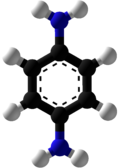1,4-Diaminobenzene
 |
|||
|
|
|||
| Names | |||
|---|---|---|---|
|
Preferred IUPAC name
Benzene-1,4-diamine
|
|||
| Other names
Paraphenylenediamine
1,4-Diaminobenzene 1,4-Phenylenediamine |
|||
| Identifiers | |||
|
3D model (JSmol)
|
|||
| ChemSpider | |||
| ECHA InfoCard | 100.003.096 | ||
| KEGG | |||
| UNII | |||
|
|||
|
|||
| Properties | |||
| C6H8N2 | |||
| Molar mass | 108.14 g·mol−1 | ||
| Appearance | White crystalline solid, darkens upon exposure to air | ||
| Melting point | 145 to 147 °C (293 to 297 °F; 418 to 420 K) | ||
| Boiling point | 267 °C (513 °F; 540 K) | ||
| 10% at 40°C, 87% at 107 C, 100% at 140 C | |||
| Vapor pressure | <1 mmHg (20°C) | ||
| -70.28·10−6 cm3/mol | |||
| Hazards | |||
| R-phrases (outdated) | R23 R24 R25 R36 R37 R38 R40 R42 R43 | ||
| S-phrases (outdated) | S26 S36 S37 S39 | ||
| Flash point | 156 °C; 312 °F; 429 K | ||
| Lethal dose or concentration (LD, LC): | |||
|
LD50 (median dose)
|
80 mg/kg (rat, oral) 98 mg/kg (rat, oral) 145 mg/kg (guinea pig, oral) |
||
|
LDLo (lowest published)
|
250 mg/kg (rabbit, oral) 100 mg/kg (cat, oral) |
||
| US health exposure limits (NIOSH): | |||
|
PEL (Permissible)
|
TWA 0.1 mg/m3 [skin] | ||
|
REL (Recommended)
|
TWA 0.1 mg/m3 [skin] | ||
|
IDLH (Immediate danger)
|
25 mg/m3 | ||
|
Except where otherwise noted, data are given for materials in their standard state (at 25 °C [77 °F], 100 kPa).
|
|||
|
|
|||
| Infobox references | |||
p-Phenylenediamine (PPD) is an organic compound with the formula C6H4(NH2)2. This derivative of aniline is a white solid, but samples can darken due to air oxidation. It is mainly used as a component of engineering polymers and composites. It is also an ingredient in hair dyes and is occasionally used as a substitute for henna.
PPD is produced via three routes. Most commonly, 4-nitrochlorobenzene is treated with ammonia and the resulting 4-nitroaniline is then hydrogenated:
In the DuPont route, aniline is converted to diphenyltriazine, which is converted by acid-catalysis to 4-aminoazobenzene. Hydrogenation of the latter affords PPD.
PPD is a precursor to aramid plastics and fibers such as Kevlar and Twaron. These applications exploit PPD's difunctionality, i.e. the presence of two amines which allow the molecules to be strung together. This polymer arises from the reaction of PPD and terephthaloyl chloride. The reaction of PPD with phosgene gives the diisocyanate, a precursor to urethane polymers.
This compound is a common hair dye. Its use is being supplanted by other aniline analogues and derivatives such as 2,5-diamino(hydroxyethylbenzene and 2,5-diaminotoluene. Other popular derivatives include tetraaminopyrimidine and indoanilines and indophenols. Derivatives of diaminopyrazole give red and violet colours. In these applications, the nearly colourless dye precursor oxidizes to the dye.
PPD is easily oxidized, and for this reason derivatives of PPD are used as antiozonants in production of rubber products. The substituents, naphthyl, isopropyl etc. affect the effectiveness of their antioxidant roles as well as their properties as skin irritants.
...
Wikipedia


